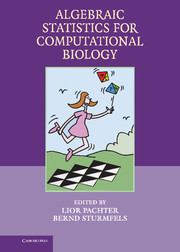Book contents
- Frontmatter
- Contents
- Preface
- Guide to the chapters
- Acknowledgment of support
- Part I Introduction to the four themes
- Part II Studies on the four themes
- 5 Parametric Inference
- 6 Polytope Propagation on Graphs
- 7 Parametric Sequence Alignment
- 8 Bounds for Optimal Sequence Alignment
- 9 Inference Functions
- 10 Geometry of Markov Chains
- 11 Equations Defining Hidden Markov Models
- 12 The EM Algorithm for Hidden Markov Models
- 13 Homology Mapping with Markov Random Fields
- 14 Mutagenetic Tree Models
- 15 Catalog of Small Trees
- 16 The Strand Symmetric Model
- 17 Extending Tree Models to Splits Networks
- 18 Small Trees and Generalized Neighbor-Joining
- 19 Tree Construction using Singular Value Decomposition
- 20 Applications of Interval Methods to Phylogenetics
- 21 Analysis of Point Mutations in Vertebrate Genomes
- 22 Ultra-Conserved Elements in Vertebrate and Fly Genomes
- References
- Index
21 - Analysis of Point Mutations in Vertebrate Genomes
from Part II - Studies on the four themes
Published online by Cambridge University Press: 04 August 2010
- Frontmatter
- Contents
- Preface
- Guide to the chapters
- Acknowledgment of support
- Part I Introduction to the four themes
- Part II Studies on the four themes
- 5 Parametric Inference
- 6 Polytope Propagation on Graphs
- 7 Parametric Sequence Alignment
- 8 Bounds for Optimal Sequence Alignment
- 9 Inference Functions
- 10 Geometry of Markov Chains
- 11 Equations Defining Hidden Markov Models
- 12 The EM Algorithm for Hidden Markov Models
- 13 Homology Mapping with Markov Random Fields
- 14 Mutagenetic Tree Models
- 15 Catalog of Small Trees
- 16 The Strand Symmetric Model
- 17 Extending Tree Models to Splits Networks
- 18 Small Trees and Generalized Neighbor-Joining
- 19 Tree Construction using Singular Value Decomposition
- 20 Applications of Interval Methods to Phylogenetics
- 21 Analysis of Point Mutations in Vertebrate Genomes
- 22 Ultra-Conserved Elements in Vertebrate and Fly Genomes
- References
- Index
Summary
Using homologous sequences from eight vertebrates, we present a concrete example of the estimation of mutation rates in the models of evolution introduced in Chapter 4. We detail the process of data selection from a multiple alignment of the ENCODE regions, and compare rate estimates for each of the models in the Felsenstein hierarchy of Figure 4.7. We also address a standing problem in vertebrate evolution, namely the resolution of the phylogeny of the Eutherian orders, and discuss several challenges of molecular sequence analysis in inferring the phylogeny of this subclass. In particular, we consider the question of the position of the rodents relative to the primates, carnivores and artiodactyls; we affectionately dub this question the rodent problem.
Estimating mutation rates
Given an alignment of sequence homologs from various taxa, and an evolutionary model from Section 4.5, we are naturally led to ask the question, “what tree (with what branch lengths) and what values of the parameters in the rate matrix for that model are suggested by the alignment?” One answer to this question, the so-called maximum-likelihood solution, is, “the tree and rate parameters which maximize the probability that the given alignment would be generated by the given model.” (See also Sections 1.3 and 3.3.)
There are a number of available software packages which attempt to find, to varying degrees, this maximum-likelihood solution. For example, for a few of the most restrictive models in the Felsenstein hierarchy, the package PHYLIP [Felsenstein, 2004] will very efficiently search the tree space for the maximum-likelihood tree and rate parameters.
Information
- Type
- Chapter
- Information
- Algebraic Statistics for Computational Biology , pp. 375 - 386Publisher: Cambridge University PressPrint publication year: 2005
Accessibility standard: Unknown
Why this information is here
This section outlines the accessibility features of this content - including support for screen readers, full keyboard navigation and high-contrast display options. This may not be relevant for you.Accessibility Information
- 2
- Cited by
